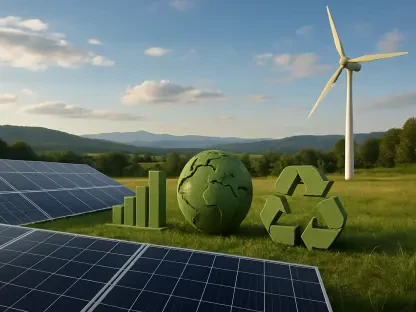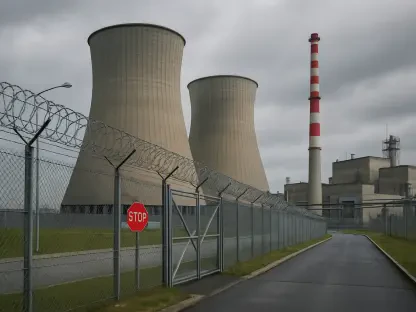In the face of escalating energy demands across the United States, particularly due to the exponential growth of large data centers, innovative energy solutions have become imperative. Data centers consume enormous amounts of electricity, akin to the daily charging of hundreds of thousands of electric cars. The current electric grid struggles to meet this demand, necessitating supplementation with alternative energy sources. Geothermal energy, specifically through the groundbreaking approach by Gradient Geothermal, stands out as a promising alternative to support this rising need for consistent and reliable energy.
Revolutionizing Geothermal Energy
Gradient Geothermal is at the forefront of transforming how geothermal energy can be harnessed, focusing on converting waste heat from existing oil and gas wells into renewable power. This novel method eliminates the need for new and costly drilling operations, which are traditionally associated with geothermal energy generation. Utilizing proprietary mobile, modular systems, Gradient captures the heat from produced fluids, converts it efficiently into electricity, and subsequently cools the fluids to meet pipeline specifications. The on-site generation of emissions-free electricity not only caters to the immense energy needs of data centers but also contributes to significant water conservation and a reduction in operational expenses by reusing water in liquid-cooling systems.
This technology by Gradient presents a dual solution—it addresses the electricity consumption challenges posed by data centers and offers an environmentally friendly and cost-effective alternative. By leveraging existing oil and gas infrastructure, Gradient bypasses the traditionally high expenses and environmental impact of new drilling projects. The ingenuity of integrating such systems into currently operational oil and gas wells paves the way for a more sustainable and economically viable method to meet the growing energy requirements.
The Need for Baseload Renewable Energy
Ensuring grid stability and continuity is the fundamental requirement that renewable baseload energy fulfills, setting it apart from intermittent sources like solar and wind power. Geothermal energy uniquely offers the critical advantage of providing continuous power, irrespective of weather conditions or the time of day. According to projections by the International Energy Agency, global energy demand is expected to increase by nearly 60% by 2040. This surge underscores the necessity for dependable energy sources like geothermal, which harness the Earth’s consistent internal heat to produce a reliable and predictable flow of electricity.
Geothermal energy’s inherent reliability makes it an ideal complement to more variable sources like solar and wind. By providing a stable baseload, geothermal energy ensures the electric grid can balance fluctuations and maintain stability. The capability to offer uninterrupted power also makes geothermal energy crucial for supporting growing demands from sectors increasingly dependent on constant and reliable electricity, such as large-scale data centers. This makes geothermal a pivotal player in the future of renewable energy.
Addressing Traditional Geothermal Challenges
Despite its promising potential, traditional geothermal energy production is riddled with significant challenges. One of the primary hurdles is the substantial cost associated with exploration and drilling, which can encompass up to half of the total project expenses. Additionally, the permitting process in the United States can take up to seven years, further delaying project commencement and escalating costs. The geographic limitations of conventional geothermal resources, predominantly found in regions with high geothermal activity, restrict widespread adoption and fail to meet demands in other areas like the eastern U.S.
Gradient Geothermal’s approach effectively addresses these traditional obstacles by utilizing existing infrastructure from oil, gas, hydrogen, helium, and lithium extraction operations. This significantly reduces both the cost and timeframe associated with exploration and drilling. Their proprietary modular field generation systems are designed to convert the hot water extracted during these operations into electricity, offering a flexible and rapidly deployable solution. By minimizing the cost and development time of geothermal projects and extending the geographical reach of potential sites, Gradient Geothermal opens up new possibilities for the application of geothermal energy in previously untapped areas.
Case Studies and Proven Success
The innovative approach of Gradient Geothermal is exemplified through successful partnerships like their collaboration with an oil and gas operation in Nevada. In this case, 81 megawatt-hours of continuous power were generated, demonstrating the efficacy of their technology even during off-peak times and across various seasonal conditions. Data from these initiatives highlight the significant cost savings and increased energy output achieved compared to traditional geothermal methods. A study by the Geothermal Energy Association underscored the advantages, citing up to a 40% reduction in project costs attributed to the utilization of existing infrastructure alongside higher energy production due to the lower fluid temperatures required by Gradient’s systems.
This case study and others like it reveal the tangible benefits of Gradient Geothermal’s methodology. By capitalizing on existing setups, the firm avoids the hefty expenses of new drilling projects and attains quicker and more efficient energy generation. Examples like the Nevada project showcase the practical application and economic feasibility of Gradient’s systems, providing a blueprint for future geothermal energy production on a broader scale.
Expanding Geothermal Energy’s Reach
Faced with increasing energy demands throughout the United States, driven largely by the rapid expansion of large data centers, finding innovative energy solutions has become urgent. Data centers draw colossal amounts of electricity, comparable to the daily charging needs of hundreds of thousands of electric vehicles. The current electric grid is struggling to keep up with this surge in demand, highlighting the need for supplementary energy sources. Geothermal energy stands out as a potent alternative, particularly through the innovative approach developed by Gradient Geothermal. Their methods promise a consistent and reliable energy supply to meet the growing needs of these massive data centers. As data demands continue to surge, leveraging renewable sources like geothermal energy could be pivotal in ensuring both energy sustainability and grid stability. Embracing such green energy solutions not only aids in meeting current demands but also significantly contributes to a more environmentally responsible energy strategy for the future.









